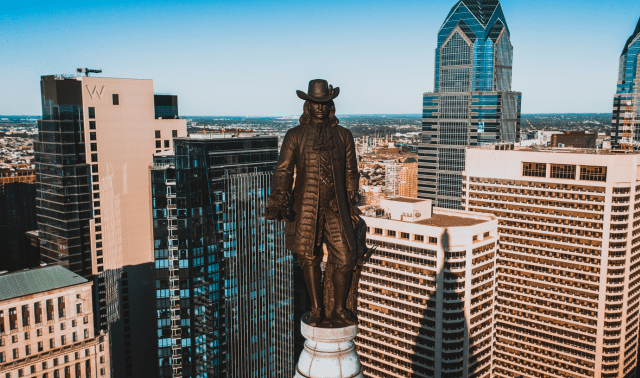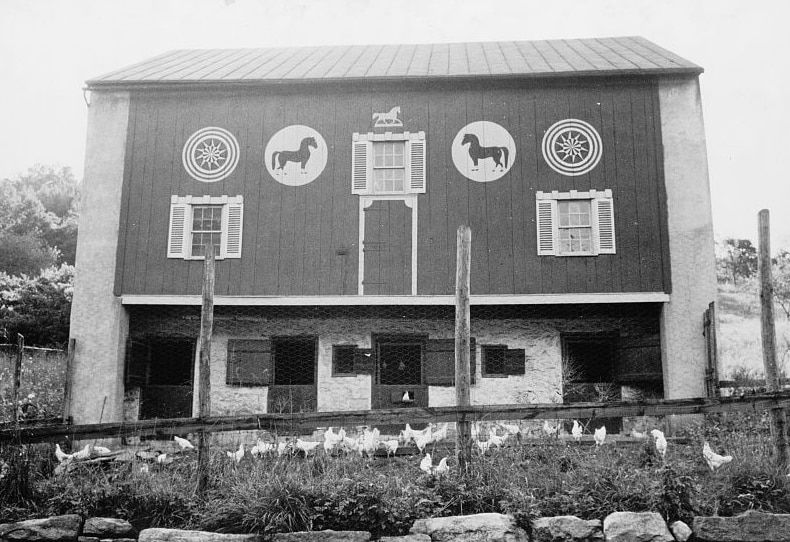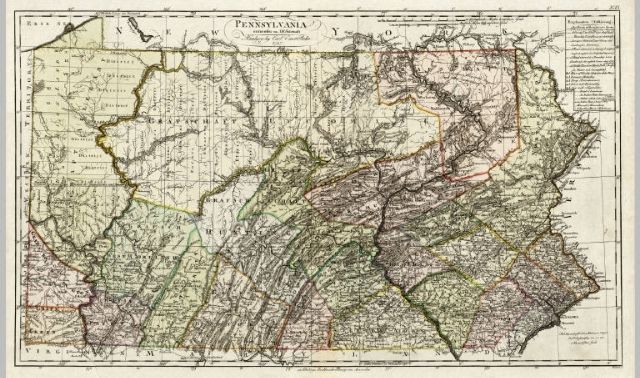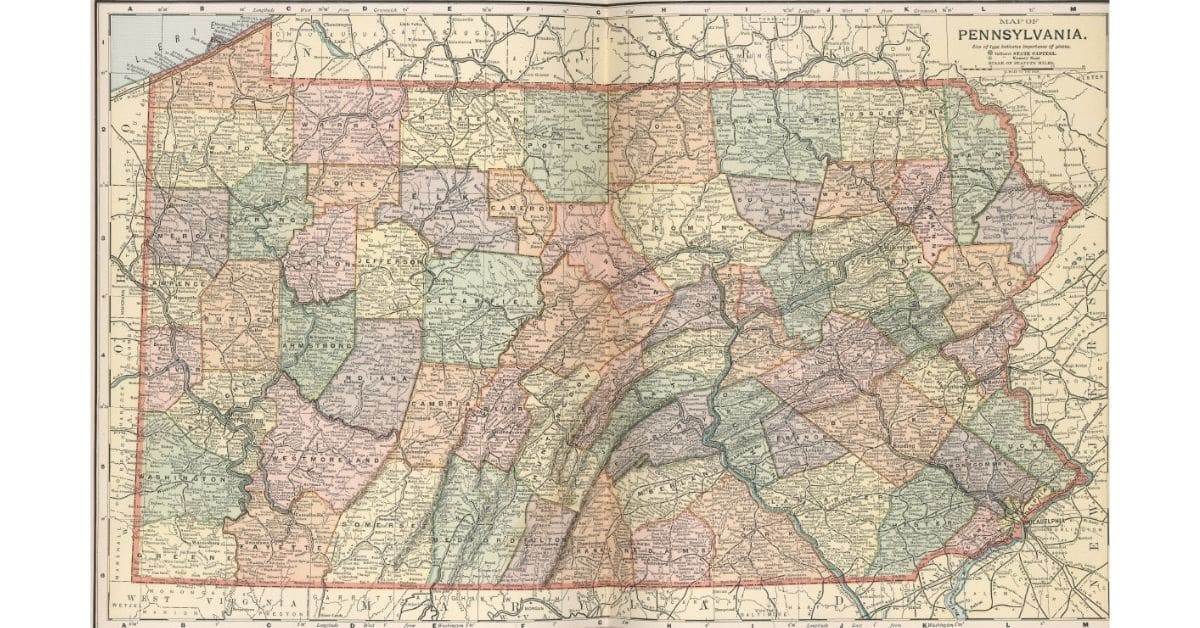As the birthplace of the Declaration of Independence and the US Constitution, Philadelphia is the backdrop for much of the United States’ founding. As the city thrived, it attracted so many people through its port that one in four Americans has at least one ancestor who spent time in the City of Brotherly Love.
You can add a new chapter to your family history with help from our guide to Philadelphia’s nearly four centuries of records.
A History of Philadelphia
Quaker William Penn settled Philadelphia as a small town between the Schuylkill and Delaware rivers in 1682. The British royal family granted Penn a generous charter, including the land that became Pennsylvania, to settle a debt owed to Penn’s father.
Penn’s declaration of religious tolerance and his family’s aggressive land policies brought a diverse cast of immigrants through Philadelphia. In a policy aimed at the many Germans, the colonial Pennsylvania legislature mandated that male foreigners age 16 and older swear allegiance to the British king.
This resulted in the only large body of immigration records for a colonial port. Start searching for early Philadelphia arrivals in the multivolume book Pennsylvania German Pioneers edited by Ralph B. Strassburger and William J. Hinke (Picton Press).
The centrally located port town grew by leaps and bounds in the mid-1700s, soon becoming the largest city in North America. This enticed a young Benjamin Franklin to seek his fortune in Philadelphia during the 1720s, founding many of the city’s longstanding institutions.
While New York City became the top port soon after the turn of 19th century, Philadelphia remained an important arrival point for immigrants. Many Scottish, Irish and Italians came in the 19th century, followed by Jews and Eastern Europeans in the early 20th century. Philadelphia also had a significant free African American population in the 1800s, in part because the Quakers were abolitionists.
With such a noble history, the city is naturally a hotbed of lineage society activity—everything from Sons of the American Revolution to the Friendly Sons of St. Patrick. And one group has Philadelphia written all over it: the Descendants of the Signers of the Declaration of Independence, one of whom rings the Liberty Bell every Fourth of July.
Timeline
- 1682 William Penn founds Philadelphia
- 1690 William Rittenhouse establishes first paper mill
- 1723 Benjamin Franklin arrives in Philadelphia
- 1774 First Continental Congress convenes
- 1776 Declaration of Independence signed in Philadelphia
- 1787 Representatives meet to hash out the US Constitution
- 1790 Philadelphia serves as temporary US capital for 10 years
- 1816 William Henry has the nation’s first private residence illuminated with gas
- 1876 Nearly 10 million visit the city’s Centennial Exhibition and World’s Fair
- 1883 Philadelphia Phillies begin play
- 2001 Kimmel Center for the Performing Arts opens
Philadelphia’s Genealogy Records
Not surprisingly, a city this rich in history has an abundance of records, but the restructuring of city boundaries and governmental agencies can make them hard to track down.
Philadelphia was originally the seat of Philadelphia County, which included what are now Montgomery and eastern Berks counties. Since 1854, the city and county of Philadelphia have been coterminous, and most county offices were eliminated in 1952. While many records are indexed at the Philadelphia City Archives, some newer records are in the original offices.
Vital records
Most birth, marriage and death records are indexed in the city archives, and you can request a search and photocopies for a fee. The city archives has included select vital records from 1794 to 1915 in a searchable subscription database at Philadelphia Land and Historic Records site. (As of July 2024, the site is temporarily unavailable to search.)
Philadelphia city and county registered births from 1860 to 1915; the city archives holds these records. In 1906, the Pennsylvania Department of Health started issuing birth certificates.
The city archives also has indexed marriage records from 1860 to 1885. The orphans court holds marriage records from 1885 to 1951, and FamilySearch has an index of these records.
Cemetery returns start in 1803, and they’re organized by cemetery at the city archives. Death registration by the city runs from 1860 to 1915, and the state department of health began issuing death certificates in 1906. FamilySearch has a searchable online index, including many original images, of Philadelphia city death certificates from 1803 to 1915.
Land records
Philadelphia deeds from 1683 to 1974 are searchable in a subscription database at Philadelphia Land and Historic Records. Deeds from 1683 to 1951 are in the city archives, and the recorder of deeds holds land records from 1952 to the present.
Newspapers
The Free Library of Philadelphia is home to a top collection of microfilmed newspapers, some 400 titles dating to 1720.
Church records
Philadelphia is chock-full of religious and other specialty repositories, with various degrees of access. The Evangelical Lutheran Church Region 7 Archives is open for public research, while the Philadelphia Archdiocesan Historical Research Center treats sacramental records as confidential and will do limited research for genealogists.
Probate records
Philadelphia probate research is complicated because estates for which there are no wills haven’t been microfilmed; they’re available only from the register of wills. The FamilySearch Library (FsL) has microfilmed probate indexes from 1682 to 1924. Especially in the Colonial era, when Philadelphia was both state capital and county seat, some estate records of people from other Pennsylvania counties are in Philadelphia County records.
Naturalization records
Philadelphia’s immigration hub status means its archives has an abundance of naturalizations. Starting in 1793, naturalization applicants appeared before the Pennsylvania Supreme Court, headquartered in the city. Since America’s independence, both city and county courts handled naturalizations; records are housed in the city archives. The National Archives and Records Administration has naturalizations performed before a federal court (1790–1991), as well as Philadelphia passenger lists (1800–1948).
City directories
After sporadic publication in the 18th century, Philadelphia directories were printed annually from 1832 to 1930. Subscription site Fold3 has directories for 1785, 1791, and 1793 to 1922. Ancestry.com has some late-19th and early-20th century directories, too.
Censuses
Philadelphia returns of the Pennsylvania Septennial Census for 1793 and 1800 are available on microfilm at the Free Library of Philadelphia. US censuses for Pennsylvania start in 1790; they’re online at Ancestry.com and Archives.com, with some on FamilySearch. You’ll find them on microfilm at the National Archives, FSL and major genealogy libraries.
Collections of the Genealogical Society of Pennsylvania include church abstracts and indexes, cemetery inscriptions, funeral home records and Bible records. Its resources are at the Historical Society of Pennsylvania’s Philadelphia headquarters, which also houses the Balch Institute for Ethnic Studies’ records and newspapers. The combined collections are a rich resource for researchers in Philadelphia and beyond.
Fast Facts
- Settled: 1682
- Incorporated: Oct. 25, 1701
- Nicknames: City of Brotherly Love, Philly
- State: Pennsylvania
- County: Philadelphia (city and county boundaries are coterminous)
- Area: 135 square miles
- Primary immigrant or ethnic groups: English, Welsh, Irish, Germans, Italians, African-Americans
- Historically important industries: Railroads, education, medicine, pharmaceuticals, finance, textiles
- Famous residents: William S. Paley, John Wanamaker, Dick Clark, Bill Cosby, Will Smith, W.C. Fields, Grace Kelly, Marian Anderson, Benjamin Franklin
- Population: 1750– 15,000; 1850– 121,376; 1900– 1,293,697; 2010– 1,526,006
Toolkit
Websites
- FamilySearch Philadelphia County Resources
- Greater Philadelphia Geo-History Network
- Philadelphia GenWeb
- Philadelphia Repository Guide
Publications
- Colonial Philadelphians by Hannah Benner Roach (Genealogical Society of Pennsylvania)
- Pennsylvania Births, Philadelphia County, 1644-1765 (vol. 1) and 1766-1780 (vol. 2) by John T. Humphrey (PA Genealogy Books)
- The Pennsylvania Genealogical Magazine (Genealogical Society of Pennsylvania)
- Philadelphia Maps 1682-1982: Townships-Districts-Wards edited by John Daly and Allen Weinberg (Genealogical Society of Pennsylvania)
Archives & Organizations
- African-American Genealogy Group of Philadelphia
- Free Library of Philadelphia
- Genealogical Society of Pennsylvania
- Historical Society of Pennsylvania
- National Archives at Philadelphia
- Philadelphia City Archives
- Philadelphia Orphans’ Court
- Philadelphia Register of Wills
- Temple University Urban Archives
Records at a Glance
Birth records
- Begin: 1860
- Privacy restrictions: Public to 1915; state certificates only thereafter
- Research tips: City archives holds birth registrations from 1860 to 1915; Pennsylvania Department of Health holds birth certificates starting in 1916.
Marriage records
- Begin: 1860
- Research tips: City archives has records from 1860 to 1915. Marriage certificates from 1916 on are available from the orphans’ court. FamilySearch.org has an online index for 1885 to 1951.
Death records
- Begin: 1803
- Privacy restrictions: Public to 1915; state issued certificates thereafter
- Research tips: Cemetery returns begin in 1803; they’re at the city archives. City death registration runs from 1860 to 1915; after that, state certificates only. FamilySearch.org has an online index of Philadelphia city death certificates from 1803 to 1915.
Deeds
- Begin: 1683
- Research tips: City archives has indexes and books through 1951, and the recorder of deeds holds records from 1952 to present.
City directories
- Begin: 1785
- Research tips: Philadelphia directories were published sporadically in the 18th century and annually between 1832 and 1930.
Censuses
- Begin: 1790
- Privacy restrictions: Open through 1950
- Research tips: Philadelphia returns of the Pennsylvania Septennial Census for 1793 and 1800 are on microfilm at the Free Library of Philadelphia
Top 5 Historic Sites
- Betsy Ross House: The legend of America’s first flag comes alive at Betsy Ross’s 250-year-old home.
- Independence National Historical Park: Among the must-sees in this park are Independence Hall, where the Declaration of Independence and US Constitution became reality, as well as the endearingly cracked Liberty Bell.
- Elfreth’s Alley: An authentic cobblestone street that’s billed as America’s “oldest residential street” dates to the beginning of the 18th century and features a museum and historical shops.
- National Constitution Center: This interactive museum celebrates the origins and evolution of America’s governing document with several exhibits, including a room with life-sized statues of each of the Constitution’s signers.
- United States Mint: Since 1792, the US Mint in Philadelphia has been the headquarters for production of the nation’s coins. Tours cover both the present state of coin manufacturing as well as its history.
A version of this article appeared in the January 2012 issue of Family Tree Magazine.







